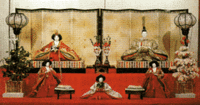

Total:131items
- Pottery & Porcelain (18)
- Lacquerware (4)
- Glasswork (2)
- Wood & Bamboo Work (19)
- Leather Work (1)
- Papermaking (13)
- Textile (20)
- Dyeing products (5)
- Masonry (1)
- Metal Work (11)
- Stationery (4)
- Livingware (3)
- Accessory (4)
- Toys & Entertainment (14)
- Hyuga Goishi: Huga Go Stones
- Kurashiki Hariko: Kurashiki Papier-mache
- Kishu Bina : Kishu Dolls
- Hakata Ningyo: Hakata Doll
- Kaga-mizuhiki: Kaga Paper Cord Ornament
- Kasukabe Oshie Hagoita: Kasukabe's battledore with a padded cloth picture
- Iwatsuki Ningyo: Iwatsuki Doll
- Tsugaru Tako: Tsugaru Kite
- Jindai-Goma: Jindai Spinning Top
- Suruga Hina Dolls
- Knohazaru: Konohazaru Dolls
- Mishima Oni Yōzu kite (Mishima Demon Kite)
- Gunma Kokeshi Doll
- Koga Ningyo: Koga Clay Doll
- Interior (2)
- Other crafts (10)

 |
Main Production Site:Shizuoka |
 《Characteristics》
《Characteristics》The major characteristics of Suruga Hina Dolls (traditional dolls of the Emperor and Empress, displayed during the Japanese Doll Festival / Girl’s Day, March 3rd) are larger straw bodies compared to other Hina dolls from various places in Japan. The bodies are carved diagonally to match the curve of the chest. The central part of Shizuoka prefecture traditionally had a large amount of rice production, and rice straw was easy to obtain. This is considered to be the reason why people used straw for the dolls’ bodies. The sharp silhouette and firm structure of the dolls are remarkable as well.
Also, Suruga Hina Dolls wear two separate pieces of kimonos; tops and bottoms, whereas the Kyoto dolls wear one-piece kimonos. This separation of top and bottom enabled the division of labor and the mass production of Hina bodies in Suruga, present day Shizuoka Pref., central Japan. Today, Suruga produces 70% of the Hina bodies in Japan.
In the manufacturing process of the Hina dolls, there is a process called “furi-tsuke” where the craftsmen bend and form the dolls’ hands. This process requires an aggregation of skills. One can even tell by the bend of the hands who created the doll. As with the kimono colors and patterns, this bend of the hands reveal the characteristics of the individual craftsman.
[ Nationally designated traditional crafts
(designated by the Minister of Economy, Trade and Industry) ]
Information provided by: Suruga Hina Dolls Traditional Craftsmen Association
Picture provided by: City Government of Shizuoka (city), Economic Affairs Bureau, Industry and Commerce Section, Division of Industrial Rehabilitation, Local industry Section
Translated by: Yukari Yamagishi
| Materials | Rice straw, woven fabric, washi paper, cotton, etc. |
|---|---|
| Crafting Processes | 【1】Fabric selection
Carefully choose the fabric by colors, motifs, and patterns within the meaning of traditional Japanese costume. 【2】Pasting process, cutting Cut the pattern paper (made of Japanese and western papers) into the doll’s size, and paste it on the backside of the fabric (“Ura-uchi” process). After the glue dries, cut the fabric accordingly to the pattern paper. 【3】 Sewing Sew the small components of the doll, by hand and machine. 【4】 Building the body On the traditional straw body, attach arms (made of wood fibers), knees, and and feet placed on the cutout cushion. 【5】 Clothing Complete the doll by assembling the numerous parts of clothing. |
| History | The most likely theory of the roots of Suruga Hina Dolls is the “Neri-tenjin (Tenjin explanations are in the next paragraph)” which is made of kneaded foxglove tree particles (“to-so”). It is said that the production of clay figures began when Yoshinari Aono from Kami-shinden, Yaizu, Shizuoka Pref. called over clay craftsmen from his grandfather’s birthtown Aonogahara, Mino Province, present day Gifu Pref., central Japan.
“Tenjin” are dolls that portray Michizane Sugawara, a scholar, poet and a politician from the Heian Period (8-12c). During the Heian Period, people worshiped “Tenjin as god of rainfall”, and later on changed into the god of calligraphy and studies. The first Tenjin doll with kimono (dressed Hina Tenjin) was made during the late Edo Period, and the oldest doll that exists today dates back to 1853 (Japanese year Kaei 6). It is said that this dressed Tenjin is the origin of Suruga Hina Dolls. Even today, the custom of displaying Tenjin dolls on top of tiered stands during the Doll Festival still remains in some local areas. It is said that the early dresses are made of velvet which is like silk satin, which are characterized by the back parts made of red vermilion paper and cropped hakama (bottom). Later on, craftsmen started making Hina dolls such as Shinno-bina (imperial prince dolls), Takasago (old couple dolls wishing an eternal love), standing Tenjin, and standing Hina dolls. In the late Edo period, Hina doll manufacturing spread nationwide; those dolls are called “Inaka-bina (literally rural hina dolls)”, and they resembled the Edo-bina (Edo, present day Tokyo dolls) and Kyo-bina (Kyoto dolls), both of which are manufactured in current and former capitals. Suruga region also started manufacturing standing Tenjin and Dairi-bina (the Emperor and Empress dolls) for Doll Festival, as well as other dolls for Boys’ Festival (on May 5th), dolls of temporal customs, and samurai dolls. Suruga’s doll production still continues today. |
◆Exhibition / Showcase
For detailed information, contact:
Suruga Hina Ningyo Dento Kogeishi-kai (Suruga Hina Dolls Traditional Crafts Association), c/o Ningyokko
Address: 4-10-21 Higashi Shinden, Suruga-ku, Shizuoka city, Shizuoka Pref. 421-0112
TEL : +81-54-257-3983 / FAX : +81-54-257-5786
◆Event Information
Assistance needed? For inquiries in English:
JTCO Contact Form
Your inquiries will be forwarded by JTCO in Japanese to the organization you wish to contact.
*Please write the name of craft you wish to ask about.



